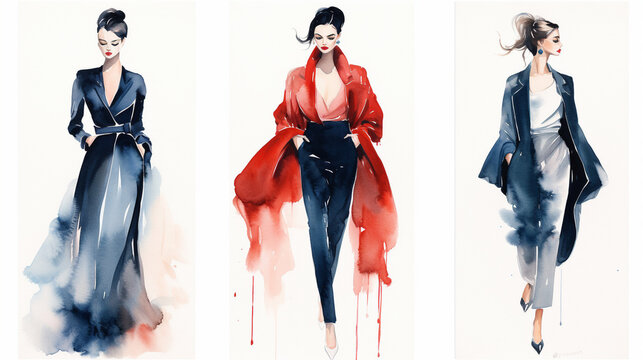
Fashion: A Global Phenomenon Shaped by Culture, Trends, and Innovation
It is not merely about clothing; it embodies a cultural expression, an evolving art form, and a powerful means of self-expression. Defined broadly, fashion encompasses trends, styles, and modes of dress that reflect the spirit of an era and the values of a society. From haute couture to streetwear, fashion transcends boundaries, shaping identities and influencing lifestyles worldwide.
The Essence of Fashion
At its core, it is a dynamic and ever-changing entity. It thrives on creativity, innovation, and the interplay between tradition and modernity. While clothing serves a practical purpose of covering the body, fashion elevates this basic need into a form of artistry. It merges craftsmanship with cultural symbolism, creating garments that convey messages of status, identity, and belonging.
The trends are not arbitrary; they emerge from a complex interplay of factors such as social movements, technological advancements, economic conditions, and individual creativity. Designers and influencers play a pivotal role in setting trends, while consumers, through their choices, validate and propagate these trends.
Globalization and Fashion
The emergence of global fashion is intricately linked to the phenomenon of globalization. As barriers between nations diminish, cultural exchange accelerates, leading to a fusion of styles and traditions. What was once confined to regional or national boundaries now traverses continents, creating a global marketplace where ideas, designs, and aesthetics converge.
Globalization has democratized fashion, making it accessible to a broader audience than ever before. Fashion weeks in major cities like Paris, Milan, New York, and Tokyo showcase not only the creativity of local designers but also serve as platforms for international collaboration and cross-cultural dialogue.
Cultural Influence and Diversity
One of the most captivating aspects of global fashion is its ability to reflect and celebrate cultural diversity. Traditional attire and indigenous designs from every corner of the globe find new life on international catwalks and in urban street style. Designers draw inspiration from historical garments, folk art, and indigenous crafts, infusing their collections with narratives that transcend geographical boundaries.
For instance, the vibrant colors and intricate patterns of African textiles have found popularity in mainstream fashion, celebrated for their boldness and authenticity. Similarly, traditional motifs from Asia, such as Japanese kimono fabrics or Indian embroideries, have been reinterpreted by designers worldwide, adding richness and diversity to global fashion.
Technology and Innovation
Advancements in technology have revolutionized every aspect of the fashion industry, from design and production to marketing and retail. Digital platforms and social media have democratized fashion criticism, enabling consumers to become influencers and trendsetters in their own right. Virtual reality (VR) and augmented reality (AR) are transforming the way consumers experience fashion, offering immersive shopping experiences and virtual catwalk shows.
Moreover, sustainable practices and ethical considerations are gaining prominence in the fashion industry. Eco-friendly materials, fair trade practices, and upcycling initiatives are becoming integral to many fashion brands’ identities, reflecting a growing awareness of environmental and social responsibility.
Fashion Capitals and Influencers
Certain cities have emerged as global fashion capitals, each with its distinctive style and influence. Paris remains synonymous with haute couture and luxury fashion houses, while Milan is celebrated for its craftsmanship and elegance. New York City is a melting pot of styles, from avant-garde streetwear to classic American sportswear. London, with its eclectic mix of tradition and innovation, fosters emerging talent and experimental design.
Influencers, celebrities, and social media personalities also wield considerable influence over fashion trends. Their endorsements can catapult niche brands into the mainstream and dictate consumer preferences worldwide. Collaborations between fashion houses and influencers have become commonplace, blurring the lines between advertising and authentic endorsement.
Challenges and Future Directions
Despite its glamour and creativity, the fashion industry faces numerous challenges. Issues such as exploitation of labor, cultural appropriation, and environmental impact continue to pose ethical dilemmas. The fast-paced nature of fashion trends has also contributed to overconsumption and waste, prompting calls for more sustainable and inclusive practices.
Looking ahead, the future of global fashion promises to be both exciting and transformative. Advancements in sustainable materials, digital innovation, and inclusivity are reshaping the industry’s landscape. As consumers become more discerning and socially conscious, there is a growing demand for transparency and accountability from fashion brands.
Conclusion
In conclusion, fashion transcends mere clothing; it embodies culture, creativity, and innovation. As the world becomes increasingly interconnected, fashion serves as a universal language, bridging diverse cultures and perspectives. Globalization has amplified the influence of fashion, transforming it into a dynamic force that shapes identities and influences lifestyles worldwide.
While challenges persist, the evolution of global fashion holds promise for a more sustainable and inclusive future. By embracing diversity, promoting ethical practices, and harnessing technological innovation, the fashion industry can continue to inspire and empower individuals while preserving the rich tapestry of global culture.
Fashion, with its ability to reflect the spirit of an era and capture the imagination, will undoubtedly remain a cornerstone of human expression and creativity in the years to come.
One response to “Fashion and its global phenomenon”
[…] are the fundamental elements through which personality is expressed. They range from everyday wear to high couture, each serving a unique purpose and […]